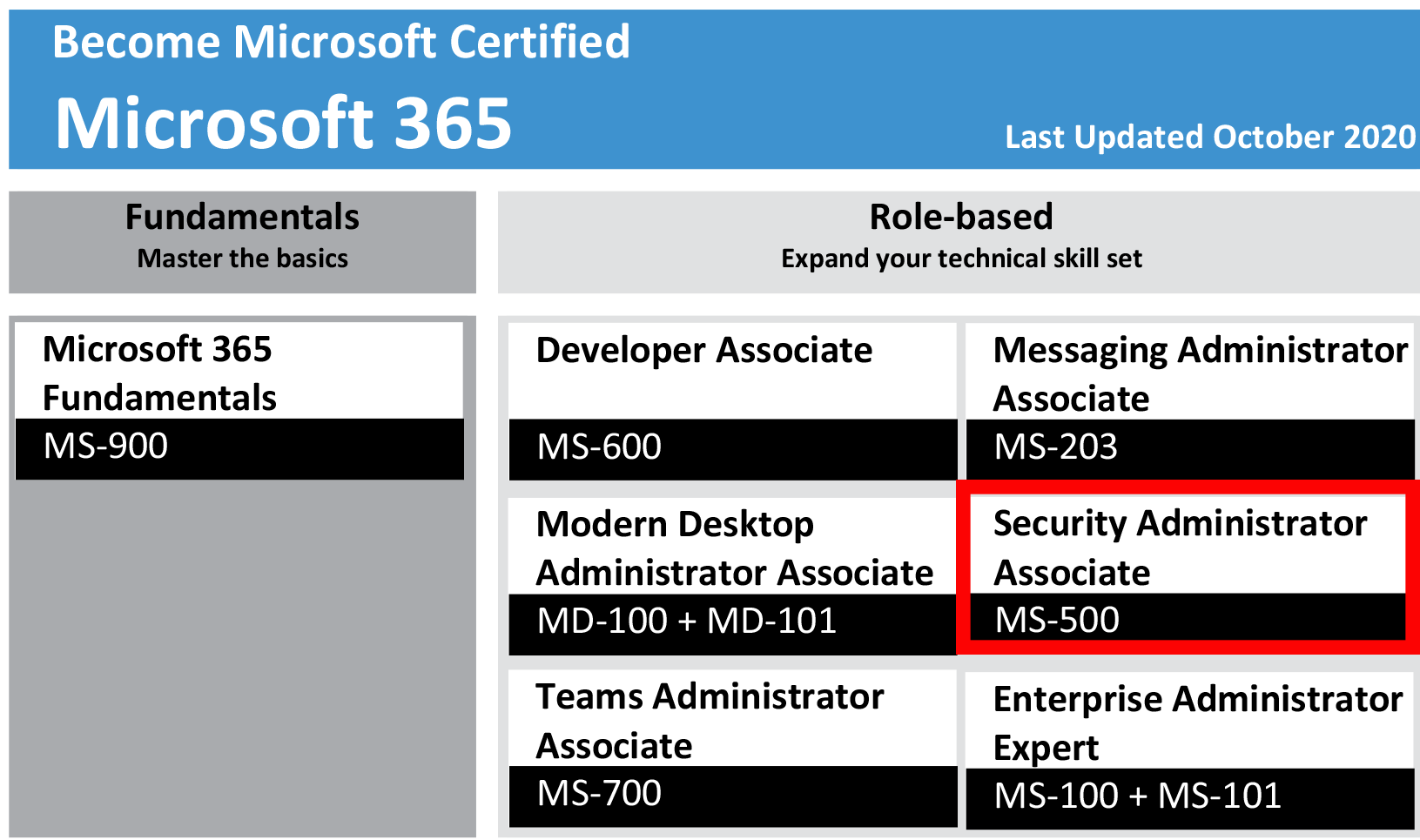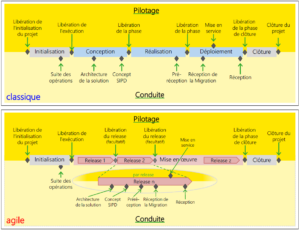Menu
MS-500 - Microsoft 365 Certified: Security Administrator Associate
Microsoft cours officiels
Home » ISEIG Cours » MS-500 – Microsoft 365 Certified: Security Administrator Associate
Ces cours sont dispensés en français sur la base d'une documentation pédagogique en anglais.
This course of 4 days is designed for IT Professionals who manage and deploy security technologies for Microsoft 365 in their organization.
These courses help learners prepare for the « Microsoft 365 Certified: Security Administrator Associate exam (MS-500) ».
This course of 4 days is designed for IT Professionals who manage and deploy security technologies for Microsoft 365 in their organization.
These courses help learners prepare for the « Microsoft 365 Certified: Security Administrator Associate exam (MS-500) ».

Modules, dates, inscription
This course is given once a semester, from 9:00 am to 12:00 pm and from 1:30 pm to 5:00 pm.
MS-500 - Microsoft 365 Certified: Security Administrator Associate
Durée
4
Prix
CHF 3000.-
Prix/j.
CHF 750.-
Cycle 1
19, 17, 24, 31 oct 2024
MS-500 - Microsoft 365 Certified: Security Administrator Associate
Durée
4
Prix
CHF 3000.-
Prix/j.
CHF 750.-
Cycle 2
3, 10, 17, 24 mar 2025
This course is given in French on the basis of documentation in French if available (Fra) or in English (Eng). If it is available in both languages, the French version is distributed unless specifically requested by the interested party.
The price of the course includes all the pedagogical documentation distributed.
The price of the course includes all the pedagogical documentation distributed.
MS-500 - Microsoft 365 Certified: Security Administrator Associate
Overview :
In this course you will learn :
- how to secure user access to your organization's resources
- how to protect user password protection, multi-factor authentication
- how to enable Azure Identity Protection
- how to configure Active Directory federation services, to setup and to use Azure AD Connect
- how to configure the Conditional Access
- the solutions for managing externat access to a Microsoft 365 system
- about threat protection technologies that help protect your Microsoft 365 environment
- about threat vectors and Microsoft's security solutions for them
- about Secure Score, Exchange Online protection, Azure Advanced Threat Protection, Windows Defender Advanced Threat Protection, and how to use Microsoft 365 Threat Intelligence
- how to secure mobile devices and applications
- how to configure a Microsoft 365 deployment to achieve your desired security posturehow to manage and deploy security technologies for Microsoft 365 in their organization
- about information protection technologies that help secure your Microsoft 365 environment, specifically information rights managed content, message encryption, as well as labels, policies and rules that support data loss prevention and information protection
- how to deploy of Microsoft Cloud App Security
- about archiving and retention in Microsoft 365 as well as data governance and how to conduct content searches and investigations
- about the data retention policies and tags, in-place records management for SharePoint, email retention, and how to conduct content searches that support eDiscovery investigations
- how to prepare for Global Data Protection Regulation (GDPR).
These courses help learners prepare for the Microsoft 365 Certified: Security Administrator Associate exam (MS-500).
Target Audience :
- IT Professionals who manage and deploy security technologies for Microsoft 365 in their organization
- IT Professional who acts as a Microsoft 365 security administrator who collaborates with the Microsoft 365 Enterprise Administrator, business stakeholders and other workload administrators to plan and implement security strategies and ensures that the solutions comply with the policies and regulations of the organization. He proactively secures Microsoft 365 enterprise environments. Its responsibilities include responding to threats, implementing, managing and monitoring security and compliance solutions for the Microsoft 365 environment. He responds to incidents, investigations and enforcement of data governance. He is familiar with Microsoft 365 workloads and has strong skills and experience with identity protection, information protection, threat protection, security management and data governance. His role focuses on the Microsoft 365 environment and includes hybrid environments.
Objectives :
After completing this course, students will be able to:
- administer user and group security in Microsoft 365
- manage passwords in Microsoft 365
- describe Azure Identity Protection features
- plan and implement Azure AD Connect
- manage synchronized identities
- plan implement federated identities
- describe and use conditional access
- describe cyber-attack threat vectors
- describe security solutions for Microsoft 365
- use Microsoft Secure Score to evaluate your security posture
- use the Security Dashboard in the Microsoft Security & Compliance center
- configure various advanced threat protection services for Microsoft 365
- configure Advanced Threat Analytics
- plan and deploy Mobile Device Management
- implement information rights management
- secure messages in Office 365
- configure Data Loss Prevention policies
- deploy and manage Cloud App Security
- implement Azure information protection for Microsoft 365
- implement Windows information protection for devices
- plan and deploy a data archiving and retention system
- perform assessments in Compliance Manager
- manage email retention through Exchange
- conduct an audit log investigation
- create and manage an eDiscovery investigation
- manage GDPR data subject requests.
Prerequisites :
This course is designed for IT Professionals who aspire to deploy and manage cloud services in their organization. Students should have the following background:
- basic conceptual understanding of Microsoft Azure
- experience with Windows 10 devices
- experience with Office 365
- basic understanding of authorization and authentication
- basic understanding of computer networks
- working knowledge of managing mobile devices
- knowledge of written English, with course materials and the certification exam being in English.
Program :
This course is composed of 14 modules including lessons and practical work (lab).
- User and Group Management
- Identity Synchronization and Protection
- Identity and Access Management
- Security in Microsoft 365
- Threat Protection
- Threat Management
- Microsoft Cloud Application Security
- Mobility
- Information Protection and Governance
- Rights Management and Encryption
- Data Loss Prevention
- Compliance Management
- Insider Risk Management
- Discover and Respond
Module 1: User and Group Management
This module explains how to manage user accounts and groups in Microsoft 365. It introduces you to the Zero Trust concept as well as authentication. The module sets the foundation for the remainder of the course.
Lessons
This module explains concepts related to synchronizing identities for Microsoft 365. Specifically, it focuses on Azure AD Connect and managing directory synchronization to ensure the right people are connecting to your Microsoft 365 system.
Lessons
This module explains conditional access for Microsoft 365 and how it can be used to control access to resources in your organization. The module also explains Role Based Access Control (RBAC) and solutions for external access. We discuss identity governance as a concept and its components.
Lessons
This module explains the various cyber-attack threats that exist. It then introduces you to the Microsoft solutions used to mitigate those threats. The module finishes with an explanation of Microsoft Secure Score and how it can be used to evaluate and report your organizations security posture.
Lessons
This module explains the various threat protection technologies and services available for Microsoft 365. The module covers message protection through Exchange Online Protection, Microsoft Defender for Identity and Microsoft Defender for Endpoint.
Lessons
This module explains Microsoft Threat Management which provides you with the tools to evaluate and address cyber threats and formulate responses. You will learn how to use the Security dashboard and Azure Sentinel for Microsoft 365.
Lessons
This module focuses on cloud application security in Microsoft 365. The module will explain cloud discovery, app connectors, policies, and alerts. You will learn how these features work to secure you cloud applications.
Lessons
This module focuses on securing mobile devices and applications. You will learn about Mobile Device Management and how it works with Microsoft Intune. You will also learn about how Intune and Azure AD can be used to secure mobile applications.
Lessons
This module focuses on data loss prevention in Microsoft 365. You will learn about how to create policies, edit rules, and customize user notifications to protect your data.
Lessons
This module explains information rights management in Exchange and SharePoint. The module also describes encryption technologies used to secure messages.
Lessons
This module focuses on data loss prevention in Microsoft 365. You will learn about how to create policies, edit rules, and customize user notifications to protect your data.
Lessons
This module explains the Compliance center in Microsoft 365. It discusses the components of compliance score.
Lessons
This module focuses on insider risk related functionality within Microsoft 365. It covers not only Insider Risk Management in the compliance center but also information barriers and privileged access management as well.
Lessons
This module focuses on content search and investigations. The module covers how to use eDiscovery to conduct advanced investigations of Microsoft 365 data. It also covers audit logs and discusses GDPR data subject requests.
Lessons
This module explains how to manage user accounts and groups in Microsoft 365. It introduces you to the Zero Trust concept as well as authentication. The module sets the foundation for the remainder of the course.
Lessons
- Identity and Access Management concepts
- The Zero Trust model
- Plan your identity and authentication solution
- User accounts and roles
- Password Management
- Set up your Microsoft 365 tenant
- Manage users and groups
- Configure Self-service password reset (SSPR) for user accounts in Azure AD
- Deploy Azure AD Smart Lockout
- Create and manage user accounts.
- Describe and use Microsoft 365 admin roles.
- Plan for password policies and authentication.
- Describe the concepts of Zero Trust security.
- Explain the Zero Trust model.
This module explains concepts related to synchronizing identities for Microsoft 365. Specifically, it focuses on Azure AD Connect and managing directory synchronization to ensure the right people are connecting to your Microsoft 365 system.
Lessons
- Plan directory synchronization
- Configure and manage synchronized identities
- Azure AD Identity Protection
- Set up your organization for identity synchronization
- Explain directory synchronization.
- Plan directory synchronization.
- Describe and use Azure AD Connect.
- Configure Azure AD Connect Prerequisites.
- Manage users and groups with directory synchronization.
- Describe Active Directory federation.
- Enable Azure Identity Protection
This module explains conditional access for Microsoft 365 and how it can be used to control access to resources in your organization. The module also explains Role Based Access Control (RBAC) and solutions for external access. We discuss identity governance as a concept and its components.
Lessons
- Application Management
- Identity Governance
- Manage device access
- Role Based Access Control (RBAC)
- Solutions for external access
- Privileged Identity Management
- MFA Authentication Pilot (require MFA for specific apps)
- MFA Conditional Access (complete an MFA roll out)
- Manage Azure resources
- Assign directory roles
- Activate and deactivate PIM roles
- Directory roles
- PIM resource workflows
- View audit history for Azure AD roles in PIM
- Describe the concept of conditional access.
- Describe and use conditional access policies.
- Plan for device compliance.
- Configure conditional users and groups.
- Configure role based access control
- Describe the concepts of identity governance
- Configure and use Privileged Identity Management
This module explains the various cyber-attack threats that exist. It then introduces you to the Microsoft solutions used to mitigate those threats. The module finishes with an explanation of Microsoft Secure Score and how it can be used to evaluate and report your organizations security posture.
Lessons
- Threat vectors and data breaches
- Security strategy and principles
- Microsoft security solutions
- Secure Score
- Improve your secure score in the Microsoft 365 Security Center
- Describe several techniques attackers use to compromise user accounts through email.
- Describe techniques attackers use to gain control over resources.
- List the types of threats that can be avoided by using EOP and Microsoft Defender for Office 365.
- Describe the benefits of Secure Score and what kind of services can be analyzed.
- Describe how to use Secure Score to identify gaps in your current Microsoft 365 security posture.
This module explains the various threat protection technologies and services available for Microsoft 365. The module covers message protection through Exchange Online Protection, Microsoft Defender for Identity and Microsoft Defender for Endpoint.
Lessons
- Exchange Online Protection (EOP)
- Microsoft Defender for Office 365
- Manage Safe Attachments
- Manage Safe Links
- Microsoft Defender for Identity
- Microsoft Defender for Endpoint
- Implement Microsoft Defender Policies
- Describe the anti-malware pipeline as email is analyzed by Exchange Online Protection.
- Describe how Safe Attachments is used to block zero-day malware in email attachments and documents.
- Describe how Safe Links protect users from malicious URLs embedded in email and documents that point
- Configure Microsoft Defender for Identity.
- Configure Microsoft Defender for Endpoint.
This module explains Microsoft Threat Management which provides you with the tools to evaluate and address cyber threats and formulate responses. You will learn how to use the Security dashboard and Azure Sentinel for Microsoft 365.
Lessons
- Security dashboard
- Threat investigation and response
- Azure Sentinel
- Advanced Threat Analytics
- Conduct a simulated Spear phishing attack
- Conduct simulated password attacks
- Describe how Threat Explorer can be used to investigate threats and help to protect your tenant.
- Describe how the Security Dashboard gives C-level executives insight into top risks and trends.
- Describe what Advanced Thread Analytics (ATA) is and what requirements are needed to deploy it.
- Configure Advanced Threat Analytics.
- Use the attack simulator in Microsoft 365. Describe how Azure Sentinel can used for Microsoft 365.
This module focuses on cloud application security in Microsoft 365. The module will explain cloud discovery, app connectors, policies, and alerts. You will learn how these features work to secure you cloud applications.
Lessons
- Deploy Cloud Application Security
- Use cloud application security information
- Describe Cloud App Security.
- Explain how to deploy Cloud App Security.
- Control your Cloud Apps with Policies.
- Use the Cloud App Catalog.
- Use the Cloud Discovery dashboard.
- Manage cloud app permissions.
This module focuses on securing mobile devices and applications. You will learn about Mobile Device Management and how it works with Microsoft Intune. You will also learn about how Intune and Azure AD can be used to secure mobile applications.
Lessons
- Mobile Application Management (MAM)
- Mobile Device Management (MDM)
- Deploy mobile device services
- Enroll devices to Mobile Device Management
- Enable Device Management
- Configure Azure AD for Intune
- Create compliance and conditional access policies
- Describe mobile application considerations.
- Manage devices with MDM.
- Configure Domains for MDM.
- Manage Device Security Policies.
- Enroll devices to MDM.
- Configure a Device Enrollment Manager Role.
This module focuses on data loss prevention in Microsoft 365. You will learn about how to create policies, edit rules, and customize user notifications to protect your data.
Lessons
- Information protection concepts
- Governance and Records Management
- Sensitivity labels
- Archiving in Microsoft 365
- Retention in Microsoft 365
- Retention policies in the Microsoft 365 Compliance Center
- Archiving and retention in Exchange
- In-place records management in SharePoint
- Initialize compliance
- Configure retention tags and policies
- Configure sensitivity labels.
- Configure archiving and retention in Microsoft 365.
- Plan and configure Records Management
This module explains information rights management in Exchange and SharePoint. The module also describes encryption technologies used to secure messages.
Lessons
- Information Rights Management (IRM)
- Secure Multipurpose Internet Mail Extension (S-MIME)
- Office 365 Message Encryption
- Configure Office 365 Message Encryption
- Validate Information Rights Management
- Describe the various Microsoft 365 Encryption Options.
- Describe the use of S/MIME.
- Describe and enable Office 365 Message Encryption.
This module focuses on data loss prevention in Microsoft 365. You will learn about how to create policies, edit rules, and customize user notifications to protect your data.
Lessons
- Data loss prevention fundamentals
- Create a DLP policy
- Customize a DLP policy
- Create a DLP policy to protect documents
- Policy tips
- Manage DLP Policies
- Test MRM and DLP Policies
- Describe Data Loss Prevention (DLP).
- Use policy templates to implement DLP policies for commonly used information.
- Configure the correct rules for protecting content.
- Describe how to modify existing rules of DLP policies.
- Configure the user override option to a DLP rule.
- Explain how SharePoint Online creates crawled properties from documents.
This module explains the Compliance center in Microsoft 365. It discusses the components of compliance score.
Lessons
- Compliance center
- Describe how to use compliance score to make organizational decisions.
- Describe how assessments are used to determine compliance score.
This module focuses on insider risk related functionality within Microsoft 365. It covers not only Insider Risk Management in the compliance center but also information barriers and privileged access management as well.
Lessons
- Insider Risk
- Privileged Access
- Information barriers
- Building ethical walls in Exchange Online
- Set up privileged access management and process a request
- Explain and configure Insider Risk Management in Microsoft 365.
- Configure and approve privileged access requests for global administrators.
- Configure and use information barriers to conform to organizational regulations.
- Build ethical walls in Exchange Online
- Configure Customer Lockbox
This module focuses on content search and investigations. The module covers how to use eDiscovery to conduct advanced investigations of Microsoft 365 data. It also covers audit logs and discusses GDPR data subject requests.
Lessons
- Content Search
- Audit Log Investigations
- Advanced eDiscovery
- Investigate your Microsoft 365 Data
- Conduct a Data Subject Request
- Conduct content searches in Microsoft 365
- Perform and audit log investigation.
- Configure Microsoft 365 for audit logging.
- Use Advanced eDiscovery





